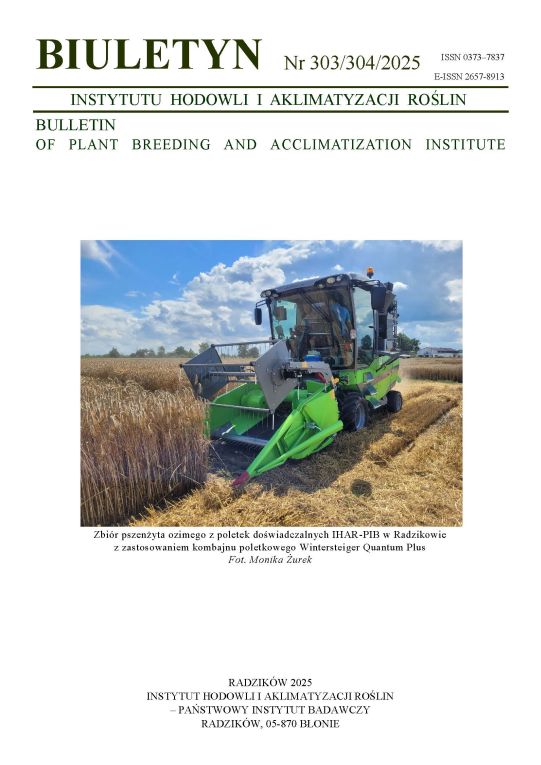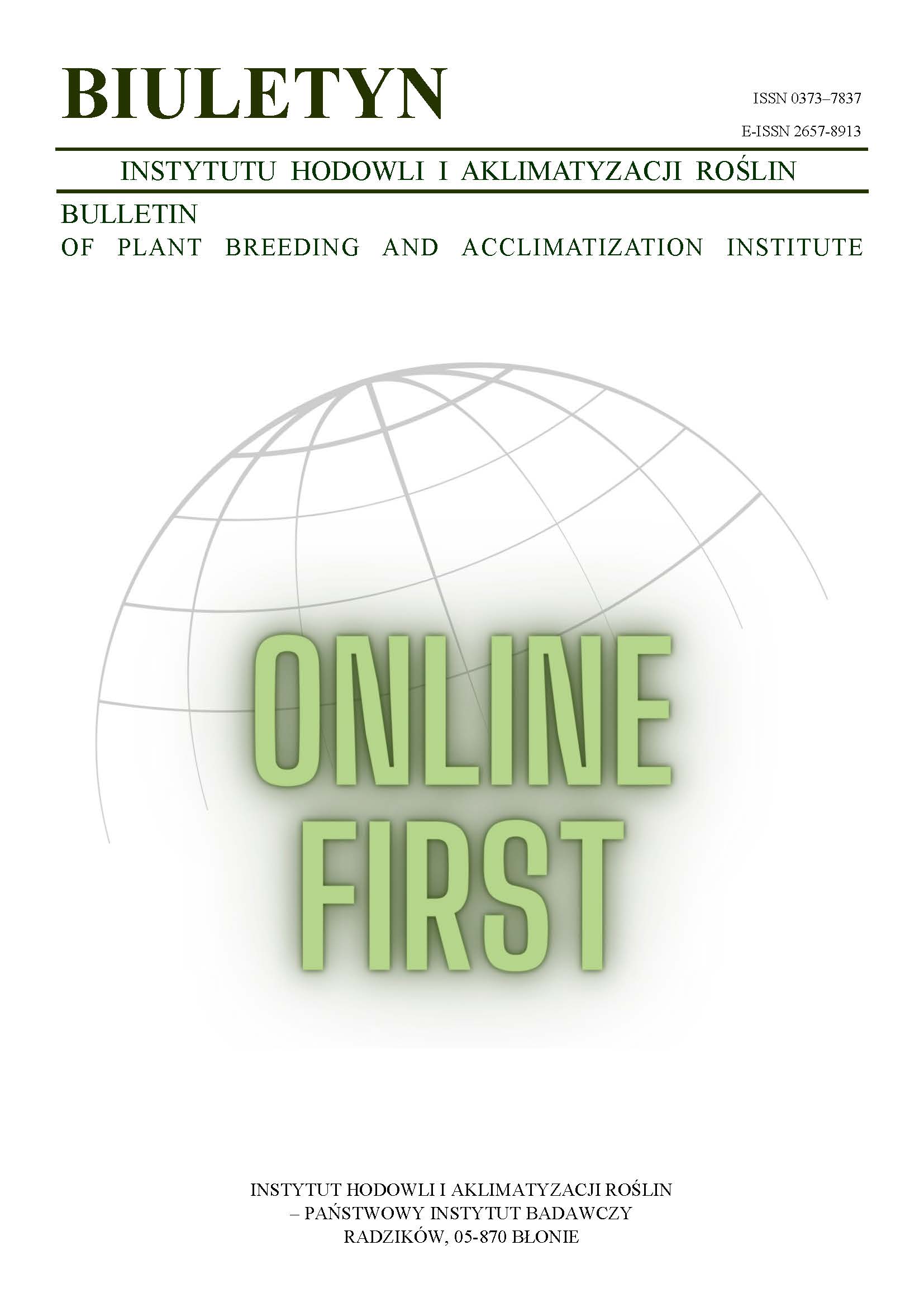Oats wholemeal as a source of dietary elements in wheat bread
Halina Gambuś
ktw@urk.edu.plKatedra Technologii Węglowodanów, Akademia Rolnicza w Krakowie (Poland)
Florian Gambuś
Katedra Chemii Rolnej, Akademia Rolnicza w Krakowie (Poland)
Elżbieta Pisulewska
Katedra Szczegółowej Uprawy Roślin, Akademia Rolnicza w Krakowie (Poland)
Abstract
Yellow hull oat, variety Kasztan and black hull oat cultivar D2244 were ground with hull, and sieved. The resulting wholemeal was used as a replacement of 5%, 7% and 10% of flour in the recipe for wheat bread. The quality and chemical composition of loaves were assessed after baking. Based upon an organoleptic evaluation all bread types were qualified as I quality class, in spite of the lower volume of bread with oats wholemeal. The differentiated share of oats did not significantly influence the texture parameters during a 3-day of storage. However the oat replacer effected a significant increase in the content of dietary fibre (soluble and insoluble fractions) and of Fe and Mn, especially in bread with black hull oats wholemeal.
Keywords:
black hull oat, dietary fibre, mineral components, quality assessment parameters of bread, yellow hull oatReferences
Analiza zbóż i przetworów zbożowych. 1981. Praca zbiorowa pod red. T. Habera i T. Jakubczyka. Skrypty SGGW-AR, Warszawa.
Google Scholar
Anonim 1980. Historical perspective: the fall and rise dietary fibre. In: Medical aspects of dietary fibre. A report of the Royal College of Physicals. Pitman Medical Ltd.: 3 — 7.
Google Scholar
AOAC 1990. Official Methods of Analysis of the Association of Analytical Chemists, 15th Edition, Arlington, Virginia, USA.
Google Scholar
Bartnik M., Rothkaehl J. 1997. Owies — zboże warte zainteresowania. Przem. Spoż. 51/ 6: 17 — 19 i 38.
Google Scholar
Bartnikowska E. 2003. Przetwory z ziarna owsa jako źródło ważnych substancji prozdrowotnych w żywieniu człowieka. Biul. IHAR 229: 235 — 245.
Google Scholar
Bartnikowska E., Lange E., Rakowska M. 2000. Ziarno owsa — niedocenione źródło składników odżywczych i biologicznie czynnych. Część I. Ogólna charakterystyka owsa. Białka, tłuszcze. Część II. Polisacharydy, włókno pokarmowe, składniki mineralne, witaminy. Biul. IHAR 215: 209 — 222 i: 223 — 237.
Google Scholar
Bartnikowska E., Piesiewicz H. 1999. Rola produktów zbożowych w profilaktyce chorób nowotworowych. Przegl. Piek. i Cuk. 47/ 7: 2 — 3.
Google Scholar
Ceglińska A., Haber T., Stelebniak A. 2003. Próba wykorzystania otrąb owsianych do wypieku wyrobów ciastkarskich. Biul. IHAR 229: 301 — 306.
Google Scholar
Gambuś H., Golachowski A., Nowotna A., Bala-Piasek A., Gumul D. 1999. Wpływ dodatku ekstrudowanych otrąb na jakość chleba pszennego. Żywność, Nauka, Technologia, Jakość, 4 (21): 128 — 140.
Google Scholar
Gambuś H., Pisulewska E., Gambuś F. 2003. Zastosowanie produktów przemiału owsa nieoplewionego do wypieku chleba. Biul. IHAR 229: 283 — 290.
Google Scholar
Gąsiorowski H. (red.). 1995. Owies. Chemia i technologia. PWRiL, Poznań.
Google Scholar
Gąsiorowski H. 2003. Wartość fizjologiczno-żywieniowa owsa. Przegl. Zboż. Młyn. 47/ 3: 26 — 28.
Google Scholar
Hasik J., Dobrzańska A., Bartnikowska E. 1997. Rola włókna roślinnego w żywieniu człowieka. Wyd. SGGW, Warszawa: 38 — 39 i 86 — 87.
Google Scholar
Kawka A., Gąsiorowski H. 1993. Wykorzystanie produktów owsianych do produkcji chleba. Przegl. Piek. i Cuk. 41, 9: 7 — 9.
Google Scholar
Kawka A., Gąsiorowski H. 1995. Produkty owsiane w piekarstwie. Przegl. Piek. i Cuk. 43, 4: 4 — 5.
Google Scholar
Klopfstein C. F., Hoseney R. C. 1987. Cholesterol lowering effects of beta-glukans enriched bread. Nutr. Rep. Intern. 36: 1091 — 1096.
Google Scholar
Oomah B. D. 1983. Baking and related properties of wheat-oat composite flours. Cereal Chem. 60: 220 — 225.
Google Scholar
Oomah B. D., Lefkowitch L. P. 1988. Optimal oxidant of wheat-oat composite flours. Die Nahrung 32: 527 — 528.
DOI: https://doi.org/10.1002/food.19880320602
Google Scholar
Piesiewicz H. 1996 a. Konsumpcja pieczywa w Polsce na tle nowoczesnych tendencji w żywieniu. Część I. Wartość energetyczna, znaczenie białka, błonnika i witamin. Przegl. Piek. i Cuk. 44, 3: 8 — 9.
Google Scholar
Piesiewicz H. 1996 b. Konsumpcja pieczywa w Polsce na tle nowoczesnych tendencji w żywieniu. Część II. Znaczenie związków mineralnych. Przegl. Piek. i Cuk. 44, 4: 4 — 7.
Google Scholar
PN-A-7410:1996. Pieczywo. Metody badań. Polski Komitet Normalizacyjny, Wyd. Normalizacyjne Alfa-Wero, Warszawa.
Google Scholar
Trowell H. 1972. Ischemic heart disease and dietary fiber. Am. J. Clin. Nutr. 25: 926 — 932.
DOI: https://doi.org/10.1093/ajcn/25.9.926
Google Scholar
Authors
Halina Gambuśktw@urk.edu.pl
Katedra Technologii Węglowodanów, Akademia Rolnicza w Krakowie Poland
Authors
Florian GambuśKatedra Chemii Rolnej, Akademia Rolnicza w Krakowie Poland
Authors
Elżbieta PisulewskaKatedra Szczegółowej Uprawy Roślin, Akademia Rolnicza w Krakowie Poland
Statistics
Abstract views: 78PDF downloads: 27
License
Copyright (c) 2006 Halina Gambuś, Florian Gambuś, Elżbieta Pisulewska

This work is licensed under a Creative Commons Attribution-ShareAlike 4.0 International License.
Upon submitting the article, the Authors grant the Publisher a non-exclusive and free license to use the article for an indefinite period of time throughout the world in the following fields of use:
- Production and reproduction of copies of the article using a specific technique, including printing and digital technology.
- Placing on the market, lending or renting the original or copies of the article.
- Public performance, exhibition, display, reproduction, broadcasting and re-broadcasting, as well as making the article publicly available in such a way that everyone can access it at a place and time of their choice.
- Including the article in a collective work.
- Uploading an article in electronic form to electronic platforms or otherwise introducing an article in electronic form to the Internet or other network.
- Dissemination of the article in electronic form on the Internet or other network, in collective work as well as independently.
- Making the article available in an electronic version in such a way that everyone can access it at a place and time of their choice, in particular via the Internet.
Authors by sending a request for publication:
- They consent to the publication of the article in the journal,
- They agree to give the publication a DOI (Digital Object Identifier),
- They undertake to comply with the publishing house's code of ethics in accordance with the guidelines of the Committee on Publication Ethics (COPE), (http://ihar.edu.pl/biblioteka_i_wydawnictwa.php),
- They consent to the articles being made available in electronic form under the CC BY-SA 4.0 license, in open access,
- They agree to send article metadata to commercial and non-commercial journal indexing databases.
Most read articles by the same author(s)
- Elżbieta Pisulewska, Julita Maciejewicz-Ryś, Halina Góral, Yield, chemical composition and protein quality in long flower head forms of red clover (Trifolium pratense L.) , Bulletin of Plant Breeding and Acclimatization Institute: No. 228 (2003): Regular issue
- Elżbieta Pisulewska, Marek Kołodziejczyk, Robert Witkowicz, Effect of cultivar and seeding rate on grain yield, its structure and morphotype of spring triticale , Bulletin of Plant Breeding and Acclimatization Institute: No. 231 (2004): Regular issue
- Halina Gambuś, Elżbieta Pisulewska, Florian Gambuś, The use of products of milled naked oat in baking bread , Bulletin of Plant Breeding and Acclimatization Institute: No. 229 (2003): Special issue
- Zbigniew J. Burgieł, Elżbieta Pisulewska, Naked oat seed-borne fungi , Bulletin of Plant Breeding and Acclimatization Institute: No. 229 (2003): Special issue
- Halina Gambuś, Marek Gibiński, Florian Gambuś, Oat maltodextrin as a replacer of fat in biscuits , Bulletin of Plant Breeding and Acclimatization Institute: No. 239 (2006): Regular issue
- Halina Gambuś, Marek Gibiński, The effect of addition of oat starch on wheat bread quality and staling , Bulletin of Plant Breeding and Acclimatization Institute: No. 229 (2003): Special issue
- Elżbieta Pisulewska, II Ogólnopolska Konferencja Naukowa Owies — Hodowla, Uprawa i Wykorzystanie , Bulletin of Plant Breeding and Acclimatization Institute: No. 229 (2003): Special issue














